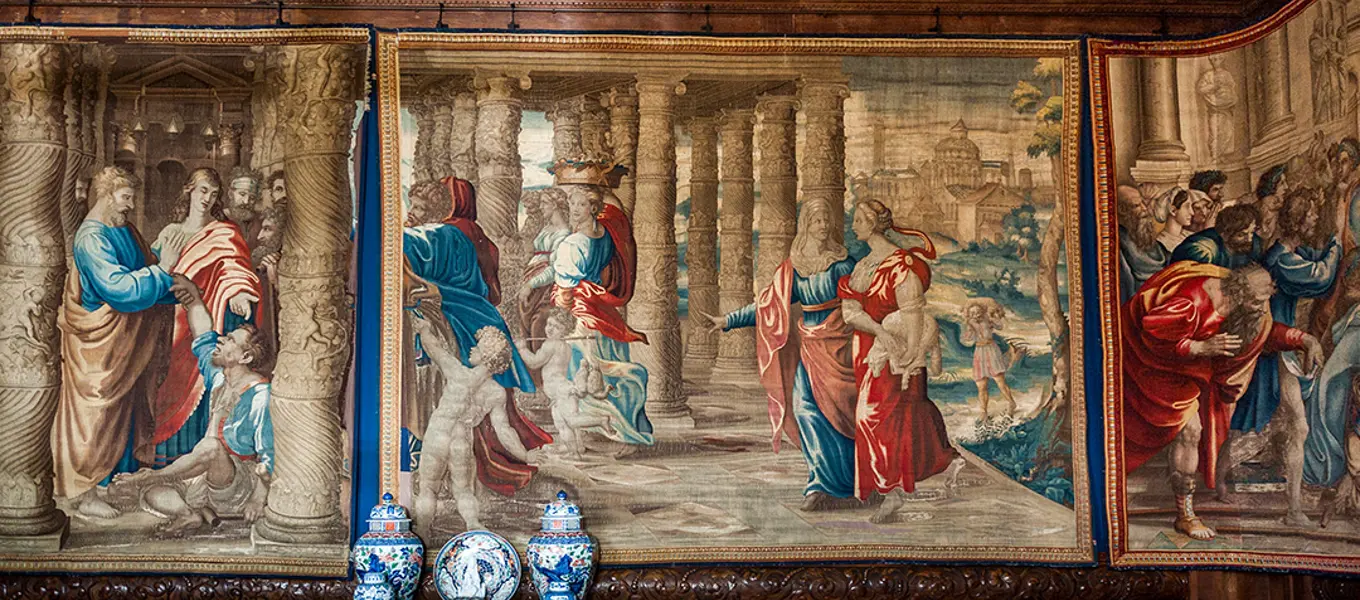Apartments of state in houses were intended for the reception of the reigning monarch, and the resident family would not have inhabited the rooms themselves. The layout and sequence of rooms is derived from the apartments in royal palaces in London and continental Europe. The decoration and furnishing of these interiors was lavish and of the highest quality to be found in the house.
By the 19th century the state rooms had become deeply unfashionable, and their survival without major alteration is unusual. They were first used for their original purpose by a visiting monarch in 1913 when George V and Queen Mary stayed at Chatsworth, using the State Bedchamber and State Music Room as their bedroom and dressing room.
In 1939 the rooms were emptied and used as dormitories for Penrhos College, a girls’ boarding school evacuated to Chatsworth during World War II. The atmosphere of this time was captured by Edward Halliday (1902-1984) who recorded the State Drawing Room in a painting which now hangs in the Green Satin Room.
The State Drawing Room served as the first withdrawing room in the state apartment, into which select members of the Court could retire from the Great Chamber.
The ceiling, by Louis Laguerre, depicts an Assembly of the Gods. In the coving there are smaller scenes telling the story of the affair between Venus, goddess of love and Mars, god of war. Vulcan, Venus’s husband who was responsible for forging weapons, is outraged when he discovers the infidelity.
The Mortlake Acts of the Apostle tapestries date to the mid 1630s, and were woven from designs by the Renaissance artist Raphael (1483-1520), originally designed for tapestries which decorate the Sistine Chapel in the Vatican. We do not know when the tapestries were moved to this location but we do know the 6th Duke reframed them in the 1830s. In 2014 a major conservation project was begun to repair and protect these important pieces of English weaving.

A section of the Mortlake Tapestries
The tapestries had suffered heavily from highly acidic atmospheric pollution known by conservators as ‘Derbyshire dirt’. Exposure to light had further degraded the tapestries, especially those opposite the windows, leaving them in a highly fragile state. One by one they were taken down, washed to remove dirt and reduce the acidity and then full remedial stitch conservation was applied to the weaving itself. The conservation of each tapestry took over a year. The final tapestry from this set was sent away for conservation in 2018.
In 2006-2007 the State Apartment was redisplayed following an in-depth research project, in order to evoke a clearer sense of how they might have looked when first furnished. The furniture is presented against the wall, as was the tradition in the 18th century, chairs only being brought into the centre when they were required.
The cabinet opposite the windows and the two similar ones are made of Chinese lacquer, and take their name from the Coromandel coast from where they were exported to Europe. Crowded on top of the cabinets are displays of Chinese porcelain, highly prized in Europe when the secret for creating true porcelain had not yet been discovered in the west.
Explore more...
Painted Hall
Used to welcome and impress guests, this was the largest and grandest room built by the 1st Duke.
Oak Room
This room was completely changed by the 6th Duke with the wood panelling he bought at an auction.
Chapel
This is the least changed room at Chatsworth, the 1st Duke employed the best artists to realise his designs.
State Bedchamber
One of the most private rooms in the State Apartment, this room was more lavishly decorated than all the others and features the State Bed.
Old Master Drawings Cabinet
This room was designed to display Old Master Drawings.
North Sketch Gallery
The North Sketch Gallery, created in 2009, showcases contemporary art and ceramics.
Oak Stairs/Leicester Landing
The stairs were created when the 6th Duke added the North Wing. They connected the old part of the house to the new.
Library and Ante Library
There are over 17,000 books in these two rooms. The whole Chatsworth book collection numbers around 40,000 volumes.
Great Dining Room
Built as part of the 6th Duke’s renovation, this room is still used for formal dinners.
Sculpture Gallery
Built by the 6th Duke, the gallery contains one of the foremost early 19th century contemporary collections of sculpture.
History of Chatsworth
Learn about the Devonshires and discover how they shaped the history of the house, garden and collection that we see today.
History of the garden
The garden evolved over nearly 500 years. Discover its history and the people who shaped it.
The Devonshire Collections
Discover highlights from the art, library and archive that make up the Devonshire Collections.
The House
Learn more about what's on in the house.



